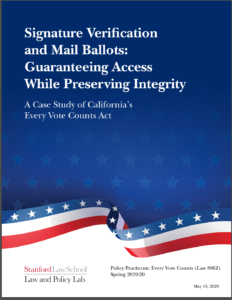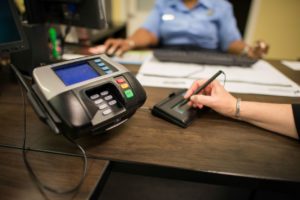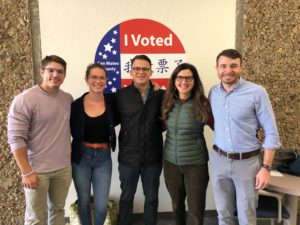
Planning for a Healthy Election Where Each Vote Counts
Written by Pranavi Kethanaboyina (Stanford BA ’22) and Eli Shi (Stanford BS ’22)
“There is a need for sustained and persistent communication by county elections offices, which is going to be very hard, given [the lack of] funding, but it is so necessary. Frequent, early, and consistent communication with voters about polling conditions and their ballot options for the general election will be critical to ensuring trust.” – Garrett Jensen (Stanford MPP / MA Education ‘20), member of the Every Vote Counts research team
In light of COVID-19 and the upcoming 2020 November elections, the need to expand voting options is more critical than ever. Whether it be expanding absentee and voting-by-mail options, maintaining and ensuring safe polling, or investing in innovations like drive-through ballot drop-offs, the preservation of voting accessibility is critical to upholding faith in American democracy. Across the country, county election offices and secretaries of state are making sometimes herculean efforts to guarantee the right to vote without jeopardizing voters’ or poll workers’ health. Many of these elections officials are expanding their voting-by-mail operations as an effective means of ensuring healthy elections.

Coincidentally timed with the emergence of the pandemic, the Stanford Law and Policy Lab Every Vote Counts Practicum (EVCA) studied an increasingly important topic: how do election officials verify mail-in ballots? Their report, Signature Verification and Mail Ballots in California, offers lessons from California which may help guide other states and counties to navigate the challenges of expanding their voting by mail operations. Over the fall term, the research team investigated how California counties are implementing a 2018 law that requires elections officials to notify voters in case the signature on their mailed ballot does not match the official signature on file with the office. Under the Every Vote Counts Act (SB 759), California counties must give such voters enough time to correct their signatures before the election is certified. The report is now circulating among all California elections offices and with other county officials across the country.

Stanford Law student Tom Westphal, who co-directed the research project, detailed the complexity of implementing voting by mail, particularly in states that have traditionally engaged in-person, election day voting. Such states do not have the infrastructure in place to rapidly scale and launch voting by mail ahead of the November election. Westphal noted, for example, that every county across the U.S. has its own unique ballot and ballot envelope. Many of these ballots are not suited to being read by machines that count mail ballots, nor does every elections office have a machine that can easily read ballot envelope signatures. Moreover, each envelope must be custom printed on special paper for the machine – yet another cost of implementing voting by mail. There are many other details that must be ironed out simultaneously: Which buildings will be used to count the ballots? Who in the office will supervise verification of voters’ signatures on the ballot envelopes? Who in the office is responsible for establishing a signature matching system? And, perhaps most importantly, who will pay for the infrastructure and resources needed to develop and implement a voting by mail system?
Garrett Jensen, a leading member of the research team, explained that the complexities of launching a voting by mail operation on short notice could increase mistakes by the elections office in accurately counting voters’ ballots. States that conduct all voting through mail-in ballots have refined their processes over many years. Where the desire might be to count every valid vote, the reality might be votes not counted due to unintended flaws in the automated process and methods used to count the ballots, not to mention due to simple human error. With any new system, election workers need time to train, recognize and correct possible errors, and generally hone their skills. Each county is responsible for developing its own training and procedures, making implementation highly variable. The end result, he said, could unintentionally disenfranchise some groups of voters.
“Because of COVID-19, things are changing rapidly. The push for voting by mail brings new opportunities and access, but a rapid push could potentially lend itself to new forms of disenfranchisement.” Ali Bloomgarden, Every Vote Counts Policy Lab Researcher (MA in Education Policy ‘20)
Who might be disenfranchised? Well, anyone whose signature doesn’t look like the one on file at the elections office. Do you know what your signature on file looks like? Most people don’t. Nor do many people know how to access that original signature to ensure that their ballot does match the one on file.
For some, a signature may vary due to an unstable writing surface or faulty pen. Have you ever signed your ballot on your lap or used a pen that doesn’t work quite right? For others, that signature might take a different form because they have purposely changed it to make it harder to copy and thus help protect themselves against fraud. For younger voters, the signature may reflect development in their cursive – which schools no longer teach – or experimentation with different loops to express their individuality. For older voters, the signature may change due to physical or neurological decline. For voters whose first alphabet is non-Western, an unfamiliarity with Western characters may make it challenging to write a consistent signature. Some senior or disabled voters may experience muscle tremors that cause an unsteady signature. And for voters who live in states with “Motor-Voter” laws that enable voters to register to vote at the time they receive their driver’s licenses, there is the inherent problem of low-resolution electronic signature pads that do not accurately record the signature. And how many of us have treated those electronic pads dismissively, scribbling down a signature just to get through the last step in the process of securing our licenses?

For these reasons, Jensen recommends that all vote-by-mail counties implement a ballot-tracking tool, such as “BallotTrax,” that enables voters to check on the status of their ballots. Such transparency in the work of the elections office lends voters confidence in the system. He further advises voters to check in with their local elections office to refresh themselves on their signature on file.
Ali Bloomgarden, who helped the team design the research methodology, said that one of her wishes for the future of voting would be to see the California Department of Motor Vehicles staff take a moment to educate drivers about the importance of the signature they provide on the electronic pad. Similarly, she highlighted the team’s research showing that an investment in higher resolution signature pads would help elections offices verify ballot envelope signatures more efficiently.
Since publication of the report, many members of the ECVA research team have joined a new effort– the Stanford-MIT Healthy Elections Projectlink1— which encompasses a variety of student research teams helping states prepare for voting under pandemic conditions. Conceived by renowned elections experts Professors Nate Persily (Stanford) and Charles Stewart (MIT), the Healthy Elections Projectlink with MIT.edu has developed a list of resources for implementing Vote-By-Mail, including resources and toolkits to assist counties in organizing and scaling-up their voting-by-mail operations. Together with their research teams, Persily and Stewart are galvanizing states and counties to adopt meticulous, careful, and comprehensive planning to fulfill their mandate to ensure safe elections where each person can enjoy their right to vote.
Given the health risks of in-person voting, many people will opt for absentee ballots and will vote from home. They may also see mail-in ballots as a way to avoid long lines at the polls where high turnout may make social distancing challenging. Similarly, as some states decrease the number of polling stations in an effort to centralize and streamline pandemic operations, lines at the polls may be longer than in past years. So, if you choose to send in your ballot by mail, the EVCA team advises you to:
- Check in with your county elections office to be sure that your registration information is current.
- Provide the election office with your current contact information, including cell phone number and email address.
- Understand that you should use the signature on file with the county and update that signature if it has changed since you first registered.
- Be sure to sign, not print, your name on the ballot return ID envelope.
- Be sure to sign your own ballot return ID envelope. Do not sign for another person, even if that person is your spouse or close relative.
Whether or not your state offers voting by mail for the November election, new, automated processes are shifting the way we vote. Just as for any other part of your life, it is important that you inform yourself of the process in your county to ensure that your vote counts.

Leave a Comment